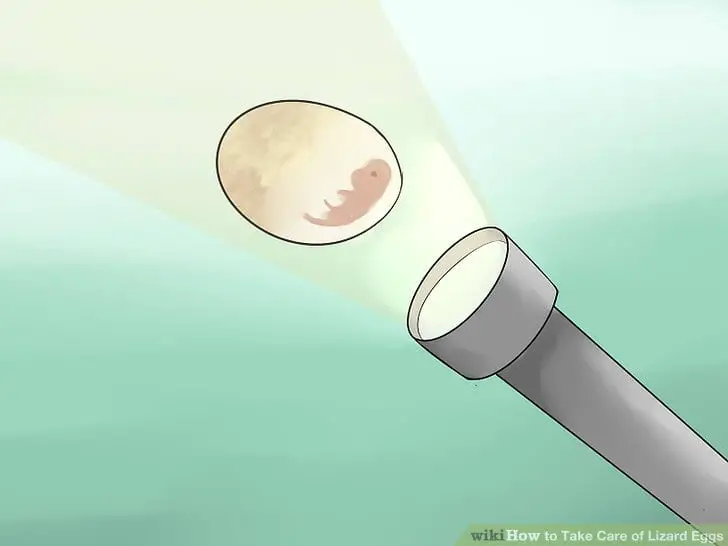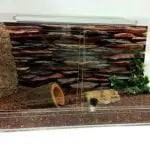So, your pet finished laying her eggs. The next best thing to do is candling the eggs. Candling is a very crucial process in handling eggs of any kind. You can use this technique to find out if the fertilized egg stopped developing. The process of candling works through illuminating the eggs’ interiors so that you can see their content.
Candling lizard eggs is not as difficult as it seems, but you need to be extra careful when doing it. If you can, candle the eggs without picking them up or handling them. Just put the candling device on the opposite part of the eggshell that has been exposed to air. Turn the lights off so that the content of the eggs will be more visible.
Normal Egg Development
In a normally developing lizard egg, you will start seeing the veins developing in the next 14 days. The top indications of development are the blood vessels and veins that are continuously growing and spreading. After a few more weeks, you will start to notice a shaking sensation on the egg as the embryo begins to wiggle inside.
Signs of Abnormal Lizard Egg Development
- The eggs are yellowing and began to dry out.
- No vein development seen after 2 to 3 weeks.
- A distinct blood spot and minimal to zero veins.
- Mold developed on or near the egg.
- The egg seems to be less developed compared to others.
- Despite the presence of these signs, the egg may eventually develop. Late development happens in some cases.
Importance of Candling Lizard Eggs

You have to understand the significance of candling lizard eggs. If you take care of the eggs of your pet, then it is important to keep the eggs in check for continuous and proper development. It can be too difficult and almost impossible to ensure that the eggs are all okay if you don’t candle them.
Keep in mind that the process of candling will involve shining the bright light on the egg. As the light touches the eggs, you will be able to see their content and check if all embryos are developing correctly.
Candling will help you identify those eggs that are viable and those that are 100% infertile. Candling, however, is highly advisable for those species that do not undergo the resting period after being laid.
If your pet is a monitor lizard, then keep in mind that the eggs of this animal generally begin to develop in no time. They absorb the available moisture in the substrate, exchange gases, and grow as fast as they can. The developing embryos start to put out tissues and blood vessels alongside the internal surface of the eggs. These blood vessels and tissues will develop outward from the central point that is usually known as the embryonic disk.
What is a Candling Device?
A candling device is the pinpointing light source which has been held at the back of the reptile eggs. It looks like a flashlight that can be powered by a plug-in cord or batteries. While the light is passing over the shell, you will see the shadow image besides you. If the reptile eggs are infertile, the image will stay clear, indicating no development.
Typically, around one week after the eggs were laid, the embryo of the fertile egg will start to grow, and you will see a tiny round disk. One week after, the disk would have grown, and most parts of the eggshells will be opaque as the light struggles to penetrate the blood vessels and tissues. After a few more weeks, the eggs will be completely opaque because the embryo and the tissues block the light.
The candling device does not have to be so specific, fancy, or expensive. In the past, people were doing this process by using the flame of the candle. The number one requirement in candling the eggs is the bright light. The brighter the light, the better.
The candling device you will be using should have an opening that is smaller compared to the diameter of those eggs you want to candle. Likewise, you need to do the candling process in a dark room without any kind of light except the light emitted by the candling device. That’s how you will see the contents of the eggs.
Where to Find a Candling Device?
A candling device is available from the bird supply sellers in your area. Look for one of the stores that sell supplies for parrot and chicken raisers. You may also use a flashlight and shine it through two pinholes in the opposite tips of the tiny metal can like the can of a tomato sauce and line it with the black paper. The holes will capture the light so that it can get into the shells better. Be extra careful when using a candle as the light might be warm enough to cause harm to the developing embryos.
Do not candle eggs daily. Instead, try to do it at around 4-5 days after they have been laid. Candle the eggs every other week, and don’t turn them when being replaced into the incubator.
You can also make a DIY candling device. Put a 60-watt bulb in a coffee can and make a 1-inch hole on the top. You can also take a bright flashlight and wrap its covering with cardboard that has a 1-inch hole in the center.
You can also use ovascope, which is a more expensive choice. This device features a turning stand where you can put an egg. Then, a hood will cover the egg to block the ambient light. You can see the egg’s interior by using an eyepiece that enlarges the egg for easier physical assessment.
Tips on Candling Lizard Eggs

If you’re struggling to see the contents of the eggs, then you may turn out the lights or go to a darker room or closet. Press your candling device and point it to the shell. Try to reduce the amount of escaping light between the candler’s rim and the shell. If you need to handpick the eggs, make sure as well that you have washed and dried your hands beforehand. The oil or moisture on your hands may block the pores of the egg and stop the embryos from accumulating the needed oxygen.
Also, you have to follow the ideal candling schedule. Candling the eggs is necessary before putting them into the incubator. Candling can also be useful in searching for the small cracks that your eyes can’t see. Cracked eggs are prone to bacteria that may penetrate and destroy the normal growth of the embryo. If one of the eggs has a crack, don’t throw it quickly. Just be sure you check the affected egg as often as you can and check its development in the long run.
Some people candle the eggs daily throughout the incubation period. However, it is better to do it on the 7th day after the eggs were laid because the eggs are sensitive to temperature. Getting them in and out of the incubator can hurt the development of the embryos. Before the 7th day come in, you won’t notice much progress on the eggs. Likewise, it will be hard to segregate good eggs from the bad ones during this period.
When you candle the eggs on the 7th day, leave them untouched until the 14th day. In this period, you can double-check the eggs you have thought to be problematic. Discard them in case they don’t show any indications of development.
Don’t candle the eggs on the 16th or 17th day. Avoid turning and moving the eggs on the periods they are waiting for the right timing to hatch. Also, the embryos are already fully developed at this period, making the eggs feel heavier than before.
If you’re taking care of monitor lizard eggs, then keep in mind that they are prone to extreme wetness or dryness. Dry eggs may dimple or collapse, which signifies the need for increased moisture. It happens sooner after the eggs were laid.
On the other hand, excess moisture being absorbed by the egg is difficult to determine. These eggs may look distorted and bloated in worst scenarios, telling that they contain too much water that can potentially drown the embryo. It often occurs shortly before the incubation period ends.
Discolored parts of the eggshells may represent colonies of harmless fungi and bacteria. These microorganisms don’t try to control the eggs except when they tend to be overwhelming. Lizard eggs are quite hardy, especially the eggs of a monitor lizard. Hence, you are more likely to succeed in taking care of the expected hatchlings. If it is your pet’s first time to breed, your odds of succeeding might be limited, but there is always a chance to try again. By following the suggested schedule for candling lizard eggs, rest assured you will have new babies to take care of sooner from today.



